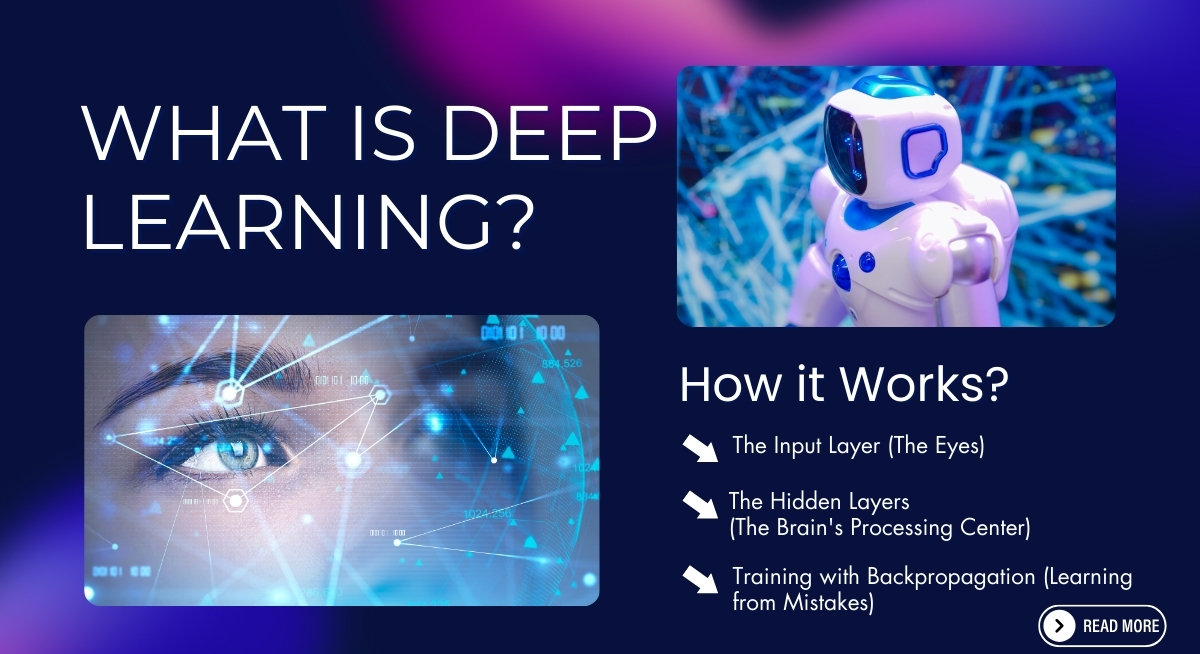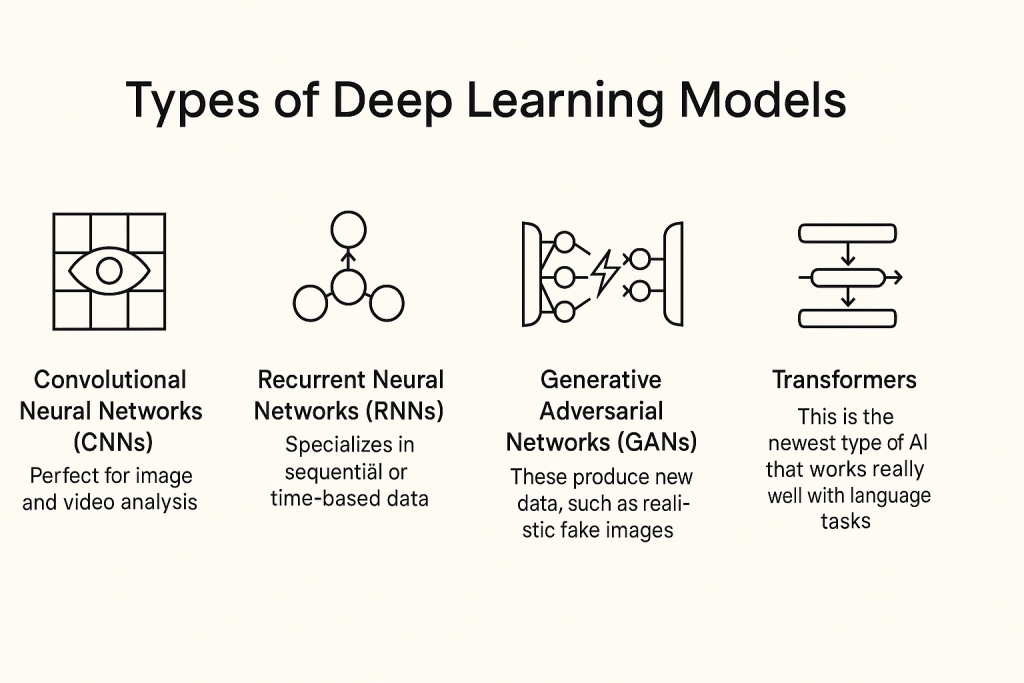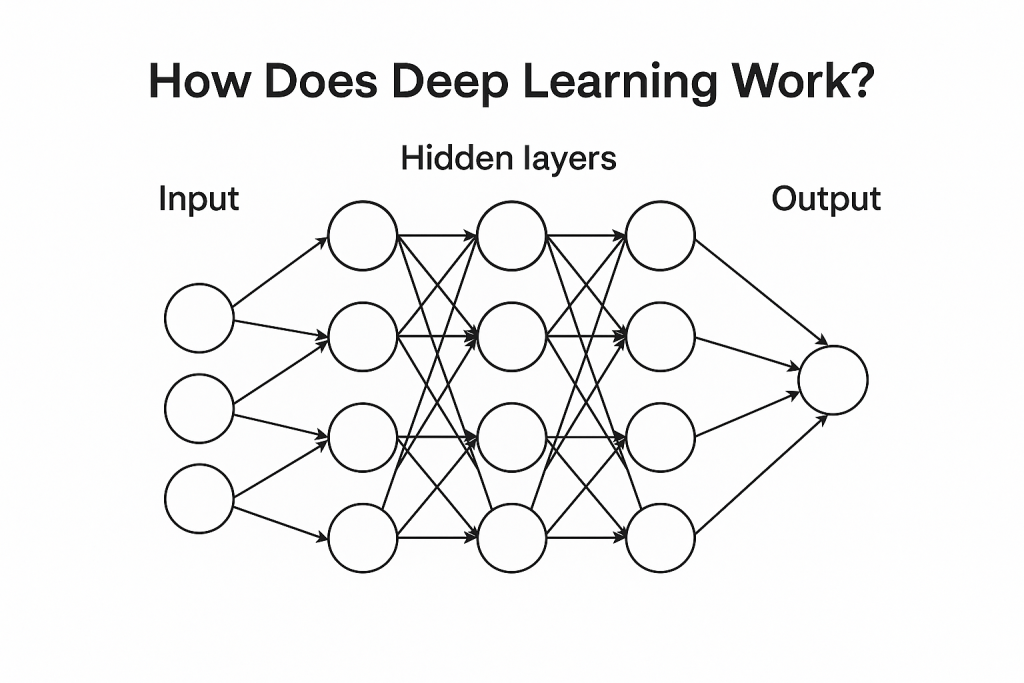
If you’ve ever wondered how self-driving cars identify objects on the road or how Alexa understands your voice, you’re already touching the world of deep learning. This breakthrough technology is a powerful subset of artificial intelligence (AI) that’s changing the way computers solve human-like problems, from language translation to cancer detection.
In fact, the global deep learning market was valued at USD 24.53 billion in 2024 and is projected to skyrocket to USD 279.60 billion by 2032, showing just how fast this technology is transforming industries worldwide.
Let’s break down deep learning in simple terms so you can see how it influences your life and the future of technology.
Deep learning is a particular type of machine learning and AI inspired by how the human brain works. Just as your brain uses connected neurons to process information and make decisions, deep learning uses artificial neural networks layered on top of each other to mimic this process.
The word ‘deep’ comes from having many layers between input (such as an image or sentence) and the final output (for example, recognizing a face or answering a question).
What makes deep learning distinct from standard machine learning is its capability to automatically discover patterns and features within massive, unstructured datasets. You don’t need to hand-design every rule or feature; instead, the system learns it on its own, which is why deep learning is behind much of the impressive AI you see today.
To understand where deep learning fits in the bigger AI landscape, check out our guide on AI vs Machine Learning: What’s the Difference? for a clearer comparison.
Many people use machine learning (ML) and deep learning (DL) interchangeably, but they’re not the same. Think of machine learning as teaching a computer to recognize patterns with some human guidance, while deep learning takes it a step further by automatically discovering those patterns through multi-layered neural networks.
Here’s a simple comparison:
| Aspect | Machine Learning | Deep Learning |
| Data Needs | Works with smaller datasets | Requires massive datasets |
| Feature Selection | Features are hand-designed by experts | Features are learned automatically |
| Model Complexity | Algorithms are simpler (e.g., decision trees, SVMs) | Complex multi-layer neural networks |
| Hardware Requirements | Can run on standard computers | Needs GPUs or cloud computing power |
| Execution Speed | Faster training on small data | Slower training but highly accurate with large data |
| Applications | Email spam detection, simple predictions | Self-driving cars, voice assistants, image recognition |
For a broader perspective on AI’s evolution, check out our related guide: AI vs Machine Learning: What’s the Difference?
You’ll find several key types of deep learning models, each suited for different tasks:
Perfect for image and video analysis, these mimic the human visual cortex.
Specializes in sequential or time-based data, such as speech or text, and can remember previous information in a sequence.
These produce new data, such as realistic fake images. They work by pitting two networks against each other, such as a generator and a discriminator.
This is the newest type of AI that works really well with language tasks like translation, summarizing text, and powering chatbots.

Imagine you want to teach a machine to recognize a picture of a cat. Here’s how a deep learning model would ‘see’ and learn:
First, the image is fed into the input layer. This layer doesn’t do any thinking; it just breaks the image down into numerical data (pixels) that the network can understand.
This is where the magic happens. The data passes through multiple ‘hidden’ layers of artificial neurons.
How does it learn? Initially, its guess is random—it might see a cat and guess “dog.” The model then compares its incorrect guess to the correct label (“cat”). It calculates the error in its guess and sends a signal backward through the network—a process called backpropagation. This signal tells each neuron how much it contributed to the mistake, and the network adjusts the connections between them to make a better guess next time.
After passing through all the layers, the data reaches the final output layer, which delivers the conclusion, like “This is a cat with 98% confidence.”

The most compelling qualities of deep learning include:
Unlike traditional machine learning, which requires experts to manually select data features, deep learning models learn and optimize features by themselves.
Deep neural networks can handle enormous, complex datasets, making them ideal for tasks like language translation, autonomous driving, and medical diagnosis.
The “deep” part means many hidden layers; more layers enable learning of more complex relationships within your data.
These models get better the more data they process and the more often they’re trained.
Deep learning’s recent exponential growth is driven by its significant advantages:
Many deep learning models now outperform humans in specific recognition tasks. For instance, achieving accuracy in diabetic retinopathy screening, reducing diagnostic errors in clinical settings, etc.
Deep learning isn’t restricted to a narrow set of problems; it powers technologies from voice assistants to fraud detection and language processing.
Models can ingest raw information and output meaningful results without much human intervention.
Deep learning automates decision-making processes, leading to significant cost and time savings in sectors like manufacturing, logistics, and customer support.
You’re likely already using products powered by deep learning, even if you don’t realize it:
Tools like Google Translate and Siri rely on neural networks to understand and respond to your language in real-time.
These vehicles use deep learning to interpret sensor data, identify objects, and make driving decisions safely.
Deep learning models analyze complex medical images, identify early disease signs, and suggest treatments.
Platforms like Netflix, Amazon, and Spotify use your viewing or shopping habits to deliver highly personalized recommendations.
Financial institutions rely on deep neural networks to detect suspicious patterns and prevent fraud in real-time.
Deep learning improves financial services by improving fraud detection, credit risk assessment, algorithmic trading, and personalized customer support.
Deep learning powers smart city solutions by optimizing traffic management, energy usage, public safety, and urban planning through real-time data analysis.
Despite its strengths, deep learning faces real obstacles:
These models need massive datasets, sometimes millions of labeled examples for training.
Training deep networks is expensive and requires powerful hardware, such as GPUs or cloud clusters.
Deep learning models are typically black boxes, making it hard to explain their decisions or diagnose errors. It is a major issue in regulated industries like healthcare and finance.
If your data is biased, the model will learn and amplify those biases, leading to unfair or inaccurate outcomes.
The energy required to train state-of-the-art deep learning models is significant. Training a single large model can emit as much carbon as five cars in their lifetimes.
Deep learning stands at the heart of today’s AI revolution, giving machines the power to learn, see, and think at a superhuman scale. Whether you interact with voice assistants, benefit from faster diagnoses at the hospital, or experience personalized shopping, deep learning is there, making data-driven magic happen behind the scenes.
Are you ready to explore what deep learning can do for you or your business? Stay curious, stay informed, and you’ll discover new opportunities in this changing AI landscape.
Deep learning is a type of artificial intelligence where machines learn from large amounts of data using structures called neural networks, similar to how your brain works.
Machine learning uses algorithms to find patterns in data, while deep learning uses layered neural networks to automatically learn features directly from raw data.
Yes, ChatGPT is based on a deep learning architecture known as a transformer, which helps it understand and generate human-like text.
You encounter deep learning in voice assistants, image recognition apps, recommendation systems, and autonomous vehicles daily.
Deep learning requires large amounts of labeled data to learn accurately, like thousands of images or text examples.
Yes, some deep learning models use unsupervised learning to find patterns without labeled data, but supervised learning with labeled data is more common.
Explore Gignaati.com – where top AI innovators showcase verified AI agents for real-world solutions.
© 2025 Gignaati is a product of Smartians.ai. All rights reserved.